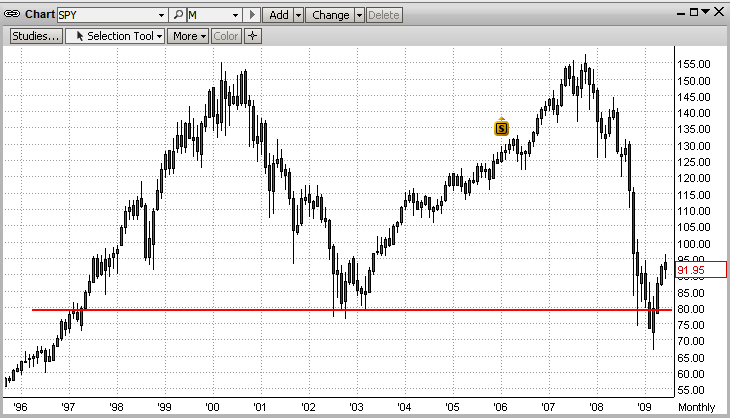Buy and Hold Strategy
"The market" is mainly made up of thousands of "fat cats" (those with over $20 billion to invest) and tens of millions of "little guys" (those with less than $10 million to invest).
Your brokerage firm, the financial institutions, and the "fat cats" tell the "little guys" to buy stocks and hold them for the duration of their lifetimes (buy/hold strategy), even when the stock market is collapsing. They tell us not to try to "time the market" ups and downs. But what do they do? Exactly the opposite. They stay 100% invested alright, but they are 100% in long positions when the stock market is headed up, and they are 100% in short positions when the stock market is tanking; and they are making $ billions along the way. So, how do the fat cats know how to time the market so accurately? It is very easy for them because (either directly or indirectly) they are "causing" the stock market changes from up-to-down and from down-to-up by their trading activities. They have tremendous buying power and their actions move the stock markets. For this reason, most stock market timers include the commercially available data on Institutional Buying (accumulation) and Selling (distribution) as one of their most reliable indicators to help them determine the future direction of the markets. The general rule is to never go against the actions of the fat cats (in other words, "follow the money".)
Click => Here's how Wikipedia reports it - "Brokerages may favor institutional investors at the expense of smaller retail investors. Perhaps consistent with these two opposing views is that, as with any type of trading, market timing is difficult to carry out on a consistent basis, particularly for the individual investor unschooled in technical analysis. Retail brokers are also generally unschooled in both the mind set and the tools needed to successfully time the market, and indeed most are actively discouraged by the brokerages themselves from moving their clients in and out of the market. However, as market makers, many of these same brokerages take the opposite approach with their large institutional clients, trading various financial instruments for these clients in an attempt to 'predict future market price movements' and thereby make a profit for the institutions. This dichotomy in the treatment of institutional vs. retail clients can potentially be controversial for the brokerages. It may suggest for example that retail brokers and their clients are discouraged from market timing, not because it doesn't work, but because it would interfere with the brokerages' market maker trading for their institutional clients. In other words, retail clients are encouraged to buy and hold so as to maintain market liquidity for the institutional trading. If true, this would suggest a conflict of interest, in which the brokerages are willing to sacrifice potential returns for the smaller retail clients in order to benefit larger institutional clients. The 2008 decline in the markets is instructive. While many retail brokers were instructed by their brokerages to tell their clients not to sell, but instead "look to the long term", the market makers at those same brokerages were busy selling to cash to avoid losses for the brokerages' large institutional clients. The result was that the retail clients were left with huge losses while the institutions fled to the safety of short term bonds and money market funds, thereby avoiding similar losses."
The main purpose of MIPS stock market timing systems is to level the playing field by providing the individual investor with a tool to help them decide when to buy/sell/short, just like the big guys. Is MIPS as accurate as the $125 million software/hardware combo that companies like Goldman Sachs use? Of course not, but it is a 1000% better than guessing on your own or listening to your broker. They simply tell you what their firm tells them to tell you, and many times this info is in their best interest, not yours.
HOW WOULD YOU HAVE DONE BUYING AND HOLDING ???
The facts about the buying and holding strategy that the fat cats do not want you to know are:
(a) almost anyone can keep up with the stock market performance in up markets
(b) the little guy gets cremated in down markets when the fat cats are mopping up by shorting
(c) during these downdrafts, the fat cats are getting rich off of the little guys, NOT from other big guys
(d) the stock market goes in cycles of up for 4-6 years and then down quickly in the next 1-2 years, and
(e) this is the way the fat cats "pump" money out of the little guys' brokerage accounts and 401K's
 From most stock market graphs, you will see that the market continuously goes up and down like a yo-yo. Many times, this up/down process repeats itself over and over for 20 years (like in the 1960-1980 time period). During this time period, the annual return was less than 1% and the market experienced 5 crashes of 25-45%. Click here to see a graph the Dow Jones for this time period.
From most stock market graphs, you will see that the market continuously goes up and down like a yo-yo. Many times, this up/down process repeats itself over and over for 20 years (like in the 1960-1980 time period). During this time period, the annual return was less than 1% and the market experienced 5 crashes of 25-45%. Click here to see a graph the Dow Jones for this time period.
More recently, the market did this twice in the last 12 years (see graph below). The stock market had remarkable gains between 1997-1999, but the "little guys" lost most of it back in 2000-2002. Again, the market had very impressive gains between 2003-2007, but again the "little guy" lost it all back in the 18 months between Oct '07 and Mar'09. The value of the little guy's portfolio in Mar'09 was about the same as it was in Mar'97 (12 years earlier) !!!

This type of market behavior has been going on forever and is NOT going to stop, so you should consider changing your current investing habits and do as the pros do.
HOW WOULD YOU HAVE DONE FOLLOWING MIPS ?
Wouldn't it be great to have a stock market timing system that allows you to participate in market gains in up markets and to KEEP YOUR GAINS in market downturns (like the fat cats always do).
 This is exactly what MIPS stock market timing systems are designed to do. If you use the MIPS Buy/Short strategy with SPY, over time you should do about 90-120% as well as Buy/Hold SPY in up markets, but you should do 50-100% better in down markets (that is, you will keep most of your upside gains AND make additional gains in DOWN markets by shorting.) Also, you could improve your performance even more by buying/shorting the Russell 3000 (IWM) instead of the SPY (or, more conservatively, by investing 50% in the SPY and 50% in IWM). See the MIPS performance tab on the homepage. Of course, for this to work for you, someone has to identify up and down markets for you and that is exactly what MIPS Timing Systems is going to do. Click Here for MIPS Investing
This is exactly what MIPS stock market timing systems are designed to do. If you use the MIPS Buy/Short strategy with SPY, over time you should do about 90-120% as well as Buy/Hold SPY in up markets, but you should do 50-100% better in down markets (that is, you will keep most of your upside gains AND make additional gains in DOWN markets by shorting.) Also, you could improve your performance even more by buying/shorting the Russell 3000 (IWM) instead of the SPY (or, more conservatively, by investing 50% in the SPY and 50% in IWM). See the MIPS performance tab on the homepage. Of course, for this to work for you, someone has to identify up and down markets for you and that is exactly what MIPS Timing Systems is going to do. Click Here for MIPS Investing